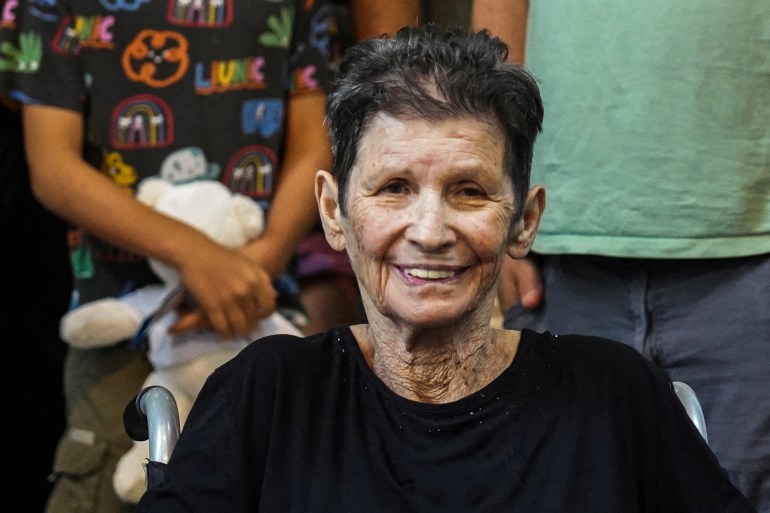Hamas said the attacks, which killed more than 1,400 Israelis, were aimed at ending “Israeli violations” at the Al-Aqsa Mosque compound, Islam’s third holiest site, and to secure the release of hundreds of Palestinian prisoners from Israeli prisons.
Since then, Israel has been pounding Gaza with nonstop aerial strikes, killing about 5,800 people, including 2,360 children, and has been preparing for a ground offensive.
So what do we know about the captives, and how many of them have been released? What are the chances for the release of the others? What do we know about Israel’s planned offensive?
Who are they?
The latest figure given by Israel’s military on Monday was 222 people, including military personnel, were being held captive in the besieged enclave.
Hamas has said more than 20 captives have been killed by Israeli air strikes.
“The murdered and the missing come from over 30 countries, including the United Kingdom,” British Prime Minister Rishi Sunak told lawmakers this month.
We don’t have all the details about the captives yet, but officials from different countries have provided some information.
Israeli authorities have not publicly named the captives so far, but a considerable number are believed to be military officers. Some are believed to be children and the elderly.
At least 10 United States citizens are still unaccounted for and are believed to be held in Gaza, according to officials. Two US nationals were released on Friday after Qatari mediation.
Thailand believes it has 17 nationals among the captives, and at least eight are Germans.
Seven British nationals and seven French citizens are still classified as missing, and some are believed to be held captive. Argentina and the Netherlands have also said they have citizens held in Gaza.

Who has been released?
Four people held in Gaza have so far been released by Hamas, keeping hopes alive that others may also be freed.
On Friday, a mother and daughter from Chicago who also hold Israeli citizenship were released.
Natalie Raanan, 17, and her mother, Judith, 59, were transferred to Egypt through the Rafah crossing with the help of the International Committee of the Red Cross (ICRC). They met with Israeli security forces in Egypt and were transferred to a military base in Israel to be reunited with their family.
📢 We facilitated the release of 2 more hostages, transporting them out of #Gaza this evening.
Our role as a neutral intermediary makes this work possible & we are ready to facilitate any future release.
We hope that they will soon be back with their loved ones.
— ICRC (@ICRC) October 23, 2023
Qatari and Egyptian mediation led to the release of two elderly Israeli women late on Monday. Yokheved Lifshitz and Nurit Yitzhak, also known as Nurit Cooper, were released on “humanitarian” grounds, according to Hamas.
The 85-year-old Lifshitz said at a news conference on Tuesday that she was hurt during the abduction but was treated well during captivity. Both women’s husbands remain captives.
Hamas has claimed it treats the captives as “guests”.
Will others be freed?
Hamas has said it wanted to release some of the captives without conditions but Israel rejected the offer. Tel Aviv has denied this claim.
Israeli media have reported that Hamas may be on the verge of releasing more than 50 captives as advanced talks are held with Israel, which had said as it ramped up its bombing campaign that it would not talk with the “terrorist” organisation.
Reports have indicated Hamas has demanded Israel allow fuel into Gaza, a request also made by human rights organisations as hospitals are fighting to keep the lights on for thousands of wounded Palestinians.
Al Jazeera, however, could not confirm the veracity of the Israeli media reports.
In addition to Qatar and Egypt, Turkey may also emerge as a mediator after its foreign minister, Hakan Fidan, said the US and several European countries have asked for help.
In addition to talking to their governments, families have taken to social media to plead for help. There have also been rallies in several countries during which demonstrators have called for the captives’ release.
The US has sent a small special operations team to help the Israeli military, but any rescue operation would be risky.
Israelis and Palestinians have a history of taking captives, and Israel has doubled its number of Palestinian prisoners to 10,000 since the Hamas attacks this month.
The most high-profile case of a prisoner exchange took place in 2011 when Israeli soldier Gilad Shalit, who was taken five years earlier, was swapped for 1,027 Palestinian prisoners.
What about the ground offensive?
Israel, which has been amassing troops and equipment on the Gaza border, said on Tuesday that a plan for a ground assault is still very much on the agenda and its military is ready to launch it despite Iranian warnings that this will escalate the war.
However, reports indicated that US President Joe Biden has asked Israel to hold off on the attack until the captives are released, saying there is “no higher priority” at the moment.
Meanwhile, The New York Times reported on Monday that US officials are not confident the Israeli military is ready for a ground invasion and cannot hope for tangible results.
The US-based news outlet Axios on Tuesday quoted two unnamed Israeli officials as saying they are willing to delay the ground offensive for a few days to allow for more talks on the captives.
Experts have said a ground offensive would carry high risks for the captives because there is no exact information on where they are being held and as many of them are believed to be held in a large network of underground tunnels beneath Gaza.
Much of northern Gaza has been levelled by Israeli bombing, and a ground war is expected to be difficult and unforgiving.
